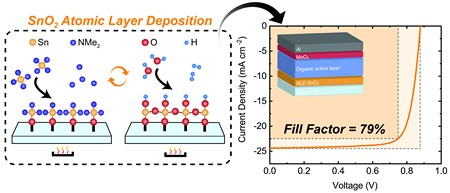Outstanding performance of organic solar cell using tin oxide
Organic solar cells have a photoactive layer that is made from polymers and small molecules. The cells are very thin, can be flexible, and are easy to make. However, the efficiency of these cells is still much below that of conventional silicon-based ones. Applied physicists from the University of Groningen have now fabricated an organic solar cell with an efficiency of over 17 percent, which is in the top range for this type of material. It has the advantage of using an unusual device structure that is produced using a scalable technique. The design involves a conductive layer of tin oxide that is grown by atomic layer deposition. The scientists also have several ideas to further improve the efficiency and stability of the cell. The results have been described in the journal Advanced Materials on 31 March.
In organic solar cells, polymers and small molecules convert light into charges that are collected at the electrodes. These cells are made as thin films of different layers—each with its own properties—that are stacked onto a substrate. Most important is the photoactive layer, which converts light into charges and separates the electrons from the holes, and the transport and blocking layer, which selectively directs the electrons towards the electrode.

Stability
‘In most organic solar cells, the electron transport layer is made of zinc oxide, a highly transparent and conductive material that lays below the active layer,’ says David Garcia Romero, a PhD student in the Photophysics and Optoelectronics group at the Zernike Institute for Advanced Materials at the University of Groningen, led by Professor Maria Antonietta Loi. Garcia Romero and Lorenzo Di Mario, a postdoctoral researcher in the same group, worked on the idea of using tin oxide as the transport layer. ‘Zinc oxide is more photoreactive than tin oxide and, therefore, the latter should lead to a higher device stability,’ he explains.
Although tin oxide had shown promising results in previous studies, the best way to grow it into a suitable transport layer for an organic solar cell had not yet been found. ‘We used atomic layer deposition, a technique that had not been used in the field of organic photovoltaics for a long time,’ says Garcia Romero. However, it has some important advantages: ‘This method can grow layers of exceptional quality and it is scalable to industrial processes, for example in roll-to-roll processing.

Scalable
The organic solar cells that were made with tin oxide deposited by atomic layer deposition on top show a very good performance. ‘We achieved a champion efficiency of 17.26 percent,’ says Garcia Romero. The fill factor, an important parameter of solar cell quality, showed values up to 79 percent, in agreement with the record values for this type of structure. Furthermore, the optical and structural characteristics of the tin oxide layer could be tuned by varying the temperature at which the material is deposited. A maximum power conversion was reached in cells with a transport layer that was deposited at 140 degrees Celsius. This same result was demonstrated for two different active layers, meaning that the tin oxide improved efficiency in a generic way.
‘Our aim was to make organic solar cells more efficient and to use methods that are scalable,’ says Garcia Romero. The efficiency is close to the current record for organic solar cells, which stands around 19 percent. ‘And we haven’t optimized the other layers yet. So, we need to push our structure a bit further.’ Garcia Romero and his co-author Lorenzo di Mario are also keen to try making larger area cells. These are typically less efficient but are needed to step towards real-world applications and panels.

Improvement
The new solar cell with an impressively high fill factor is a good starting point for further development. Garcia Romero: ‘It may be a bit early for industrial partners to take this on; we need to do some more research first. And we hope that our use of atomic layer deposition will inspire others in the field.’ ‘We always strive to understand what is happening in a material and in a device structure,’ adds Professor Loi. ‘Here, we think that there might be room for improvement. In that process, our tin oxide transport layer is a great initial step.’ This class of solar cells may make an important extra contribution to the energy transition because of their mechanical properties and their transparency. ‘We expect that they will be used in a totally different way than silicon panels,’ says Loi. ‘We need to think broader and out of the box at the moment.’
Reference: Lorenzo Di Mario, David Garcia Romero, Han Wang, Eelco K. Tekelenburg, Sander Meems, Teodor Zaharia, Giuseppe Portale and Maria A. Loi: Outstanding Fill Factor in Inverted Organic Solar Cells with SnO2 by Atomic Layer Deposition. Advanced Materials, online 31 March 2023.
More news
-
11 December 2025
Stormy planets and an unexpected atmosphere
-
09 December 2025
University of Groningen Professor at COP30: ‘There is always drama’
